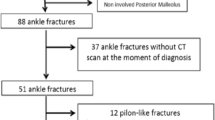Abstract
Background
Classification of ankle fracture is important when deciding for operative or conservative treatment. This study rates the reproducibility of ankle stability assessment and compares it with the classification by Lauge-Hansen and Arbeitsgemeinschaft für Osteosyntesefragen (AO) in adult patients with primary ankle fractures.
Methods
A total of 496 consecutive ankle fractures were included, and the X-ray images were reviewed 2 times by 2 medical students, 2 residents, and 1 consultant in orthopedic traumatology. The raters were blinded to each other and to their own results. Unweighted Kappa statistics were used to assess reproducibility.
Results
Overall mean (95% CI) interrater Kappa results were 0.65 (0.64; 0.68) for Lauge-Hansen, 0.62 (0.60; 0.63) for AO and 0.61 (0.57; 0.62) for the stability assessment. The intrarater results ranged from a mean Kappa of 0.64–0.80 for the medical students, 0.65–0.81 for the residents and 0.82–0.84 for the consultant.
Conclusion
The stability assessment has substantial to almost-perfect agreement which is comparable to the Lauge-Hansen and AO classifications.

Similar content being viewed by others
References
Court-Brown CM, Caesar B (2006) Epidemiology of adult fractures: a review. Injury 37(8):691
Court-Brown CM, Biant L, Bugler KE, McQueen MM (2014) Changing epidemiology of adult fractures in Scotland. Scott Med J 59(1):30
Elsoe R, Ostgaard SE, Larsen P (2018) Population-based epidemiology of 9767 ankle fractures. Foot Ankle Surg 24(1):34
Toth MJ, Yoon RS, Liporace FA, Koval KJ (2017) What’s new in ankle fractures. Injury 48(10):2035
Broos PL, Bisschop AP (1991) Operative treatment of ankle fractures in adults: correlation between types of fracture and final results. Injury 22(5):403
Lauge-Hansen N (1950) Fractures of the ankle. II. Combined experimental-surgical and experimental-roentgenologic investigations. Arch Surg 60(5):957
Müller ME, Nazarian S, Koch P, Schatzker J (1990) The comprehensive classification of fractures of long bones. Springer, Berlin
Fonseca LLD, Nunes IG, Nogueira RR, Martins GEV, Mesencio AC, Kobata SI (2018) Reproducibility of the Lauge-Hansen, Danis-Weber, and AO classifications for ankle fractures. Rev Bras Ortop 53(1):101
Alexandropoulos C, Tsourvakas S, Papachristos J, Tselios A, Soukouli P (2010) Ankle fracture classification: an evaluation of three classification systems: Lauge-Hansen, A.O. and Broos-Bisschop. Acta Orthop Belg 76(4):521
Verhage SM, Rhemrev SJ, Keizer SB, Quarles van Ufford HM, Hoogendoorn JM (2015) Interobserver variation in classification of malleolar fractures. Skelet Radiol 44(10):1435
Pakarinen HJ, Flinkkil TE, Ohtonen PP, Ristiniemi JY (2011) Stability criteria for nonoperative ankle fracture management. Foot Ankle Int 32(2):141
Michelson JD (2013) Using decision analysis to assess comparative clinical efficacy of surgical treatment of unstable ankle fractures. J Orthop Trauma 27(11):642
Kottner J, Audige L, Brorson S, Donner A, Gajewski BJ, Hrobjartsson A, Roberts C et al (2011) Guidelines for reporting reliability and agreement studies (GRRAS) were proposed. J Clin Epidemiol 64(1):96
EpiData Association. Available at: http://www.epidata.dk/. Accessed 1 Jan 2010
Sim J, Wright CC (2005) The kappa statistic in reliability studies: use, interpretation, and sample size requirements. Phys Ther 85(3):257
Landis JR, Koch GG (1977) The measurement of observer agreement for categorical data. Biometrics 33(1):159
Cordova CB, Dunn JC, Kusnezov N, Bader JM, Waterman BR, Orr JD (2018) Comparing clinician use of three ankle fracture classifications. JAAPA 31(2):36
Thomsen NO, Overgaard S, Olsen LH, Hansen H, Nielsen ST (1991) Observer variation in the radiographic classification of ankle fractures. J Bone Joint Surg Br 73(4):676
Viberg B, Bartholin ML, Weber K, Bech RD, Palm H, Schultz-Larsen M (2016) High reliability of a scoring system for implant position in undisplaced femoral neck fractures. J Orthop Trauma 30(8):432
Author information
Authors and Affiliations
Corresponding author
Ethics declarations
Conflict of interest
The authors declare that they have no conflict of interest.
Additional information
Publisher's Note
Springer Nature remains neutral with regard to jurisdictional claims in published maps and institutional affiliations.
Rights and permissions
About this article
Cite this article
Viberg, B., Haidari, T.A., Stork-Hansen, J. et al. Reproducibility of the stability-based classification for ankle fractures. Eur J Orthop Surg Traumatol 29, 1125–1129 (2019). https://doi.org/10.1007/s00590-019-02404-8
Received:
Accepted:
Published:
Issue Date:
DOI: https://doi.org/10.1007/s00590-019-02404-8




